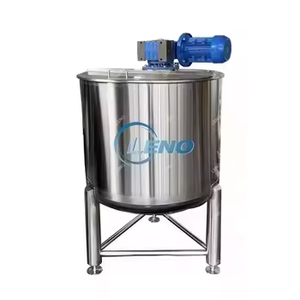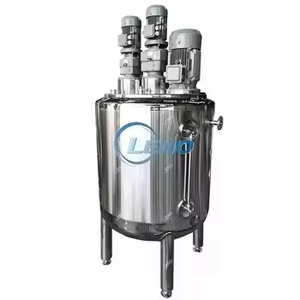
All categories
Featured selections
Trade Assurance
Buyer Central
Help Center
Get the app
Become a supplier

(1138 products available)


























Market Overview: The global sewage agitator mixer market is poised for notable growth, driven by increasing demands in wastewater management and treatment processes. According to Research and Markets, the industrial agitators market, which includes sewage agitator mixers, reached a valuation of approximately USD 2.1 billion in 2023 and is projected to grow to USD 3.0 billion by 2032, reflecting a compound annual growth rate (CAGR) of 4.0% during this period. This growth is largely attributed to the rising focus on sustainable waste management solutions and the need for efficient mixing in various industrial applications, particularly in the food and beverage sector. The continuous evolution of wastewater treatment technologies further reinforces the relevance of sewage agitator mixers in enhancing operational efficiencies.
Regional Insights and Key Players: The sewage agitator mixer market is characterized by significant regional variations. North America and Asia-Pacific are leading in market share, with North America accounting for nearly 30% of the industrial agitators market. Asia-Pacific is expected to showcase the fastest growth, driven by rapid industrialization and increased investments in wastewater infrastructure. Key players in this sector include Dynamix Agitators Inc., EKATO Holding Gmbh, and SPX FLOW Inc., who are actively innovating to meet the stringent demands of modern wastewater treatment facilities. Additionally, consumer behavior is shifting towards eco-friendly solutions, prompting companies to adopt advanced mixing technologies that reduce energy consumption and operational costs. This trend is crucial as industries increasingly prioritize sustainability, aligning with global environmental goals.
Adding chemicals, breakdown products, and air to sewage treatment is essential for the stabilization of effluent, sludge, and residuals by using a sewage agitator mixer. By dispersing treatment chemicals into the sewage, the mixer improves the homogeneous mixing of the entire sewage. A mixer also helps prevent the build-up of solid or sludge layers on the treatment tank floor.
A sewage mixer can be chosen from several types described below:
The following are some of the key specifications one should note when considering a sewage mixer agitator:
Overall, the sewage mixer agitator requires routine maintenance practices to ensure it works well over an extended period of time. Manufacturers require users to read the user manual so as to follow the recommended maintenance practices. Generally, the maintenance practices can be summarized into five main servicing schedules. During the installation inspection, users ought to inspect mixer bolts and check if they are loose. They should also look for any signs of damage or wear and tear on the sealing components and ensure the mixer has been setup in accordance to the manufacturer’s instructions.
During regular operation inspections, users should routinely check the temperature of the motor and see if it is operating well within the recommended standards. Also, users should inspect the sealing components and ensure they are not wearing out or exhibiting any leakage signs. Apart from eventually replacing sealing components, users should also inspect the impeller. If any damages are identified, prompt replacement should be done to ensure efficient fluid mixing is achieved.
Users should also monitor load conditions and see if the mixer is handling the recommended capacity and weight. If the mixer works on a weight or load that is beyond its capacity, then equipment failure may occur. Users should also conduct regular lubrication on movable parts of the mixer in order to enhance smooth movement. In case, the mixer gets submerged in corrosive sewage, timely cleaning and anti-corrosive treatment should be conducted to avoid damages.
Sewage mixing agitators are widely used in sewage treatment plants, waste disposal facilities, wastewater treatment facilities, chemical manufacturing plants, food and beverage processing plants, pulp and paper mills, tanneries, marinas, hotels, farms, and other places where wastewater is generated. Here are some examples of how sewage mixing agitators can be used in different industries and application scenarios.
Sewage treatment plants
Sewage mixing agitators are the key pieces of equipment in sewage treatment plants. They help mix sewage and chemicals uniformly, accelerating reaction and making efficient use of sedimentation and filtration. In sewage treatment plants, an agitator will be used in sedimentation tanks, reaction tanks, and bio-reactors.
Waste disposal facilities
In waste disposal facilities, sewage mixing agitators can mix sewage and waste to achieve uniform processing. Meanwhile, the sewage agitator helps to reduce the volume of waste, make settling easier, and improve the processing efficiency.
Chemical manufacturing
In chemical manufacturing, the sewage mixing agitator can mix chemicals and wastewater uniformly, promoting chemical reactions. Besides, it can help dilute and neutralize toxic chemicals to make them safe to dispose of.
Food and beverage processing
In food and beverage processing, the sewage mixing agitator can mix wastewater and chemicals uniformly to promote chemical reactions. It also helps dilute concentrations of organic matter to facilitate treatment.
Pulp and paper mills
In pulp and paper mills, sewage mixing agitators can deal with organic matter and chemicals in paper-making processes. They mix paper effluents and chemicals to react uniformly. Meanwhile, the agitators assist in diluting organic matter concentration to facilitate subsequent treatment processes.
Textile manufacturing
In textile manufacturing, the sewage agitator can mix textile effluents and chemicals uniformly to promote chemical reactions and assist in the separation of fibers and dyes.
Marinas
Marinas can produce oil, sewage, and other pollutants. Sewage mixers can mix wastewater and oil-absorbing agents evenly, accelerating oil absorption and separation and reducing pollutant concentrations.
Hotels
In the hotel industry, large amounts of sewage are generated. Sewage mixing agitators can be used to treat the hotel wastewater so that it can meet standards to enter municipal sewage treatment systems.
Farming
For wastewater and organic matter produced in farming, sewage mixing agitators can mix waste, chemicals, and water uniformly, which promotes the degradation of organic matter to reduce pollutant concentrations.
When buying a sewage agitator for the treatment plant or any other associated application, the following factors to maximize efficiency and cut expenses should be considered:
Q1: How does a sewage agitator mixer work?
A1: The agitator mixer uses a rotating shaft and impeller to create sewage flow. The impeller, which is attached to the shaft, rotates when the motor power is supplied. The rotation creates a drawing force that pushes the sewage downward. The force causes the sewage to flow circularly or to mix.
Q2: Which type of sewage agitator mixer should clients use?
A2: Consider factors like sewage depth, volume, density, temperature, mixer power, mixer shaft length, sewage mixer motor type, and mixer design before deciding. Choosing the right agitator will ensure efficient treatment and reduce harmful substance emission.
Q3: Are sewage agitator mixers expensive?
A3: The mixers' prices vary based on the type, brand, specification, and power.
Q4: Do operators have to maintain sewage agitator mixers?
A4: Yes, regular maintenance is required to ensure proper and continuous mixing. Check the motor and impeller for wear and tear. If there is any damage, repair it promptly. Anti-corrosion coatings will extend the lifespan of the mixer.